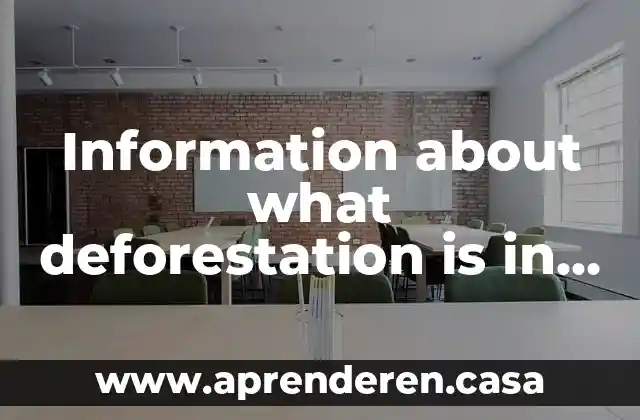Deforestation is a global environmental issue that affects ecosystems, climate, and biodiversity. Understanding what deforestation means in English is essential for raising awareness and promoting sustainable practices. In this comprehensive guide, we will explore the definition, causes, effects, and solutions related to deforestation, all in English, to ensure clarity and accessibility for a wide audience.
What is deforestation?
Deforestation is the large-scale removal of trees from forests, usually to make way for agriculture, urban development, logging, or mining. This process can lead to the destruction of ecosystems, loss of biodiversity, and contribute to climate change. When forests are cleared, the carbon stored in trees is released into the atmosphere, increasing greenhouse gas emissions.
Deforestation has been a critical issue for centuries, but the rate has accelerated in the modern era. During the 19th and early 20th centuries, vast tracts of forest were cleared in Europe and North America to expand agriculture and build cities. Today, tropical regions like the Amazon, Congo Basin, and Southeast Asia are the most affected. In fact, it’s estimated that around 18.7 million acres of forests are lost every year globally.
Another significant impact of deforestation is the disruption of water cycles. Trees play a crucial role in absorbing and distributing water, and their removal can lead to desertification, soil erosion, and reduced rainfall in certain areas. These effects can have cascading consequences on agriculture and local communities that depend on these natural resources.
The link between deforestation and climate change
Deforestation is closely tied to climate change because forests act as carbon sinks, absorbing carbon dioxide from the atmosphere. When trees are cut down and burned or left to rot, the stored carbon is released back into the air, worsening the greenhouse effect. This process is a major contributor to global warming.
In addition to emitting carbon, deforestation reduces the planet’s capacity to absorb CO₂. According to the Food and Agriculture Organization (FAO), deforestation accounts for nearly 10% of global greenhouse gas emissions. This makes it one of the most pressing environmental challenges of our time.
Deforestation also affects local climates. For example, in the Amazon, the loss of forest cover has been linked to changes in rainfall patterns and temperature increases. This not only impacts wildlife but also threatens the livelihoods of indigenous communities and farmers who depend on stable environmental conditions.
The role of illegal logging in deforestation
Illegal logging is a major driver of deforestation, especially in tropical countries. It involves cutting down trees without proper authorization, often in protected or indigenous lands. This activity is difficult to monitor and control, and it thrives in areas with weak governance and enforcement.
The consequences of illegal logging go beyond environmental damage. It also undermines local economies by depriving communities of sustainable forest resources. Additionally, it fuels corruption and organized crime, creating a cycle of exploitation and environmental degradation.
Efforts to combat illegal logging include international agreements like the European Union’s Forest Law Enforcement, Governance and Trade (FLEGT) Action Plan, which aims to reduce illegal timber trade. However, more needs to be done to enforce these policies and protect the world’s remaining forests.
Examples of deforestation around the world
Deforestation occurs in various regions around the globe, each with its own set of causes and consequences. One of the most well-known examples is the Amazon Rainforest, where large areas are cleared for cattle ranching and soybean production. The Amazon is often referred to as the lungs of the Earth due to its role in producing oxygen and regulating the planet’s climate.
Another example is Indonesia, where deforestation is driven by palm oil plantations. This has led to the destruction of habitats for endangered species such as the orangutan and Sumatran tiger. Similarly, in Africa, the Congo Basin faces deforestation due to logging, agriculture, and mining.
Here are some key examples of deforestation and their causes:
- Amazon Rainforest (South America): Cattle ranching and soy farming.
- Congo Basin (Africa): Logging and mining.
- Southeast Asia (Indonesia, Malaysia): Palm oil plantations.
- Central America: Coffee and banana plantations.
- Russia: Logging for timber export.
Each of these cases highlights the need for global cooperation and sustainable land-use policies to mitigate the effects of deforestation.
The concept of reforestation and afforestation
Reforestation and afforestation are two key strategies to combat deforestation. Reforestation refers to replanting trees in areas that have been deforested, while afforestation involves planting trees in areas that were previously non-forested.
These practices are essential for restoring ecosystems and reducing carbon emissions. For example, the Bonn Challenge is an international effort aiming to restore 350 million hectares of degraded land by 2030. Countries like China and India have launched massive tree-planting campaigns to offset their carbon footprints.
Reforestation can also provide economic benefits through ecotourism, sustainable timber production, and carbon credit programs. However, it is not a simple solution. The success of reforestation depends on factors such as the type of trees planted, the involvement of local communities, and the long-term maintenance of the forests.
Top 10 facts about deforestation in English
Here are ten important facts about deforestation in English:
- Deforestation contributes to about 10% of global greenhouse gas emissions.
- The Amazon Rainforest is losing about 17% of its forest cover, which could trigger irreversible damage.
- Each year, 4,000 species are lost due to deforestation.
- Deforestation affects water cycles and increases the risk of droughts.
- Around 1.6 billion people rely on forests for their livelihoods.
- Tropical deforestation releases more carbon than the entire global transportation sector.
- Deforestation can lead to soil erosion and decreased agricultural productivity.
- The loss of forests impacts indigenous communities and their cultural heritage.
- The world has lost 420 million hectares of forest since 1990.
- Reforestation and sustainable land use are key solutions to reversing deforestation.
These facts underscore the urgency of addressing deforestation and implementing effective conservation strategies.
The impact of deforestation on wildlife
Deforestation has a devastating effect on wildlife, leading to habitat loss, species extinction, and disruption of ecological balance. Many species depend on forests for food, shelter, and breeding. When forests are cleared, these animals are left without a home, often leading to population decline or even extinction.
For example, the orangutan is critically endangered due to the destruction of its habitat in Borneo and Sumatra for palm oil plantations. Similarly, the Amazon is home to countless species, including jaguars, harpy eagles, and poison dart frogs, all of which are at risk due to deforestation.
In addition to individual species, entire ecosystems are affected. Forests are complex systems where plants, animals, and microorganisms interact. The removal of trees can lead to the collapse of these systems, making it difficult for nature to recover.
What is the purpose of understanding deforestation?
Understanding deforestation is essential for developing strategies to protect the planet. By learning about the causes and effects of deforestation, individuals and governments can make informed decisions that promote sustainability. Education and awareness are key to encouraging responsible consumption and supporting conservation efforts.
For instance, consumers can choose products certified by the Forest Stewardship Council (FSC), which ensures that the wood or paper used is from responsibly managed forests. Governments can implement policies that protect forests, enforce anti-logging laws, and support reforestation projects.
In schools and universities, incorporating environmental education into curricula helps students understand the importance of preserving natural resources. This knowledge can inspire future leaders to advocate for environmental protection and sustainable development.
Alternatives to deforestation
There are several alternatives to deforestation that can help reduce the demand for forest land. One of the most effective is agroforestry, which combines agriculture with tree planting. This practice allows farmers to grow crops while maintaining tree cover, improving soil health and biodiversity.
Another alternative is sustainable agriculture, which focuses on maximizing crop yields without expanding into forested areas. Techniques like crop rotation, organic farming, and permaculture help maintain soil fertility and reduce the need for deforestation.
Additionally, urban planning can play a role in reducing deforestation. By designing cities with green spaces and promoting vertical farming, urban areas can expand without encroaching on forests. These innovative approaches help balance economic development with environmental protection.
The economic cost of deforestation
Deforestation not only harms the environment but also has significant economic consequences. Forests provide valuable ecosystem services, such as water purification, soil stabilization, and carbon sequestration. When forests are lost, these services are disrupted, leading to increased costs for water treatment, flood control, and soil restoration.
For example, deforestation in the Himalayas has led to increased flooding in downstream areas, damaging infrastructure and affecting millions of people. In Southeast Asia, the loss of mangrove forests has made coastal communities more vulnerable to typhoons and storm surges.
Moreover, deforestation can reduce tourism revenue and affect industries that rely on forest resources. Many countries depend on ecotourism for income, and the destruction of forests can lead to a decline in visitors and economic losses.
What does deforestation mean?
Deforestation means the deliberate clearing of forested land for other uses. It is a complex process that involves the removal of trees, often on a large scale, and can have long-term consequences for the environment and human societies. The term is sometimes used interchangeably with forest degradation, which refers to the gradual loss of forest quality due to overuse, pollution, or climate change.
Deforestation is not just about cutting down trees; it also includes the destruction of the entire forest ecosystem. This includes the loss of plant and animal species, changes in water cycles, and the release of carbon into the atmosphere. Understanding the meaning of deforestation is the first step in addressing the issue and finding sustainable solutions.
In many cases, deforestation is driven by economic factors such as agriculture, logging, and mining. However, it is also influenced by policy decisions, consumer demand, and global trade. Addressing deforestation requires a multi-faceted approach that involves governments, businesses, and individuals working together.
What is the origin of the term deforestation?
The term deforestation is derived from the prefix de- meaning removal or removal from, and the word forest. It was first used in the 19th century to describe the large-scale clearing of forests for agricultural or industrial purposes. The concept gained prominence during the industrial revolution, when forests were cleared to make way for factories, railways, and farmland.
The word has its roots in Latin, where forest comes from foris, meaning outside, and silva, meaning wood. Over time, the term evolved to refer specifically to the clearing of wooded areas. Today, deforestation is a widely recognized term used in environmental science, policy, and conservation.
Understanding the origin of the term helps contextualize the historical and cultural factors that have contributed to deforestation over the centuries.
Alternative terms for deforestation
In addition to deforestation, there are several related terms that describe the process of clearing forests. These include:
- Forest clearing: A general term for removing trees from a forested area.
- Forest degradation: The decline in the condition of forests due to human activity.
- Forest loss: The reduction in forest cover over time.
- Land conversion: The transformation of forested land into other uses, such as agriculture or urban development.
- Tree felling: The act of cutting down trees, often in a commercial or industrial setting.
Each of these terms highlights a different aspect of the deforestation process. While deforestation refers specifically to the complete removal of forest cover, the other terms describe partial or gradual changes in forest ecosystems.
The importance of protecting forests
Protecting forests is crucial for maintaining biodiversity, regulating the climate, and supporting human livelihoods. Forests are home to more than 80% of terrestrial species and provide essential resources such as food, medicine, and clean water. They also play a vital role in absorbing carbon dioxide and producing oxygen.
In addition to their environmental benefits, forests have cultural and spiritual significance for many indigenous communities. These communities have lived in harmony with forests for centuries, relying on them for food, shelter, and traditional practices. Protecting forests is therefore not only an environmental issue but also a matter of social justice.
Efforts to protect forests include establishing protected areas, enforcing anti-logging laws, and promoting sustainable land use. International cooperation is essential for addressing the global nature of deforestation and ensuring that forests are preserved for future generations.
How to use the term deforestation in English
The term deforestation can be used in various contexts to describe the clearing of forests. Here are some examples of how to use it correctly in English:
- Deforestation is one of the leading causes of climate change.
- The government is working to reduce deforestation in the Amazon.
- Many organizations are campaigning against deforestation to protect wildlife.
- Deforestation has a significant impact on local communities and biodiversity.
- Scientists warn that continued deforestation could lead to irreversible damage.
It is important to use deforestation in the context of environmental discussions, policy debates, and scientific research. The term is often used in news articles, academic papers, and environmental reports to describe the loss of forest cover and its consequences.
The role of individuals in combating deforestation
While governments and corporations play a major role in deforestation, individuals can also contribute to the solution. By making informed choices, reducing consumption of products linked to deforestation, and supporting conservation efforts, individuals can help protect forests.
Some practical steps individuals can take include:
- Buying certified sustainable products (e.g., FSC-certified paper and wood).
- Reducing meat consumption, as livestock farming is a major driver of deforestation.
- Supporting reforestation projects through donations or volunteering.
- Spreading awareness by educating others about the importance of forests.
- Advocating for stronger environmental policies through petitions and public campaigns.
By taking these actions, individuals can help reduce the demand for products that contribute to deforestation and promote sustainable practices.
The future of deforestation and forest conservation
The future of deforestation will depend on the actions taken today. With the growing awareness of climate change and environmental degradation, there is increasing pressure on governments, businesses, and consumers to adopt more sustainable practices.
Technological innovations such as satellite monitoring, drones, and AI are being used to track deforestation in real time and enforce anti-logging laws. These tools provide valuable data that can help policymakers make informed decisions and hold companies accountable for their environmental impact.
However, challenges remain. Political instability, corruption, and economic pressures continue to drive deforestation in many regions. To address these challenges, a global commitment to forest conservation is essential. International cooperation, funding, and public support will be key to ensuring that forests are protected for future generations.
INDICE







